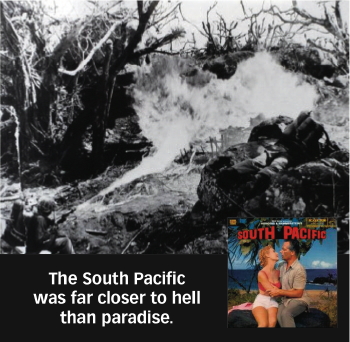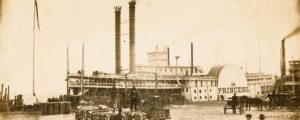Last week I made a startling claim about the uniqueness of the Pacific War.
Well, startling for me, anyway. I’ve come up in a school that distrusts the very word “unique.” Most historians eschew the concept. Indeed, the very job of a historian is to compare events from various epochs and to show how all events of the present owe something to those of the past.
As a card-carrying historian, I get that. But even so, I still think that the Pacific War was unlike anything before or since. At sea, the distances involved dwarfed any previous military conflict. Consider the battle of Leyte Gulf in 1944, for example. The deployment area was some 450,000 square miles, more than the American states of Utah, Colorado, Arizona, and New Mexico combined. As a result, traditional notions of fleet battle, with battleships steaming line ahead and exchanging gunfire with their counterparts similarly arrayed, never came into play. Rather, the opposing fleets stayed hundreds of miles apart and the aircraft carrier became the principal weapon of destruction. The encounter at the Coral Sea in May 1942 was a milestone for that reason, the first naval battle in history in which the hostile ships never came within sight of one another.
 While the fleets and carriers were roaming free over a major portion of the globe—maneuver personified, we might call it—the fighting on land was of a very different character. Here, individual islands witnessed one brutal battle of attrition after another, with Japanese soldiers fighting to the last man and U.S. forces having to vaporize them one by one with superior firepower. Today, we tend to see the typical battle as a “storm landing,” an amphibious assault on a tiny island, with the Japanese defending on the water’s edge and the Americans landing under fire. Think of Tarawa in November 1943, for example. But anyone with a cursory understanding of the Pacific knows that it is filled with larger islands like New Guinea and Leyte, and here the Japanese had no prospect of defeating a landing. On the big islands, U.S. forces often landed unopposed, then had to confront a series of heavily fortified ridges, hills, and caves in the interior. Finally, there were many islands like Peleliu, where the Japanese decided to follow both strategies: carrying out a murderous defense at the water’s edge as well as a fight to the death in the interior. Any way you sliced it, it could take months for U.S. infantry to wipe out Japanese resistance. It was a ugly business of brutal close assaults, demolition charges, and flamethrowers.
While the fleets and carriers were roaming free over a major portion of the globe—maneuver personified, we might call it—the fighting on land was of a very different character. Here, individual islands witnessed one brutal battle of attrition after another, with Japanese soldiers fighting to the last man and U.S. forces having to vaporize them one by one with superior firepower. Today, we tend to see the typical battle as a “storm landing,” an amphibious assault on a tiny island, with the Japanese defending on the water’s edge and the Americans landing under fire. Think of Tarawa in November 1943, for example. But anyone with a cursory understanding of the Pacific knows that it is filled with larger islands like New Guinea and Leyte, and here the Japanese had no prospect of defeating a landing. On the big islands, U.S. forces often landed unopposed, then had to confront a series of heavily fortified ridges, hills, and caves in the interior. Finally, there were many islands like Peleliu, where the Japanese decided to follow both strategies: carrying out a murderous defense at the water’s edge as well as a fight to the death in the interior. Any way you sliced it, it could take months for U.S. infantry to wipe out Japanese resistance. It was a ugly business of brutal close assaults, demolition charges, and flamethrowers.
In close quarters like these, the conditions were horrid for both sides. Historian Ronald Spector put it best when he wrote that the “real enemy” in the Pacific wasn’t a hostile army. It was the jungle. Let us take Guadalcanal, for example. It was an island covered by tropical rain forest: razor-sharp grasses, crawling vines, ferns bigger than a man, tangled roots, giant hardwood trees that blocked out the sun. On “the Canal,” as U.S. combatants called it, the heat and humidity was such that your men could make something like one to two miles per day before exhaustion set in. The Japanese didn’t have it any easier than the Americans did. Tales of the Japanese being skilled at jungle warfare are mythological. Sure, they might have trained for it a little better, but they weren’t raised in it any more than a boy from Cleveland, Ohio was, and there were just as many jungles on Japan as there are in America—that is to say, none. Visibility for both sides was nil, a few hundred yards at most. It was a world of giant ants, massive wasps, and mosquitos that gave you malaria. Quinine (the standard anti-malarial medicine) was always in short supply. American scientists, ever inventive, did manage to devise a synthetic substitute called Atabrine. Unfortunately, rumors had already spread among U.S. troops that Atabrine suppressed your sexual desire or made you impotent. So there was that. A more immediate threat was the humidity. It was a constant, clinging menace to you, your rifle, your clothing, your skin, and your feet. One nasty word: fungus.
Jungle wasn’t the only problem in the Pacific, however. Even a non-jungle island like Iwo Jima could be a nightmare. Iwo was a hunk of volcanic rock four miles long by two miles wide, made up of gritty, irritating ash that stunk like sulfur. That was bad enough, until you realize that the entire island was honeycombed by Japanese tunnels, some as deep as 75 feet. U.S. troops have fought in some rotten places since 1945, from the Chosin Reservoir in Korea to the Iron Triangle in Vietnam to the Shar-i Kot valley in Afghanistan. As bad as they were, none of them was worse than Iwo Jima or Guadalcanal.
 The point I am making here is that the Pacific Theater was a mess. Whether jungle island or tiny coral atoll or volcano: the fighting was never less than horrible, dehumanizing, and brutalizing. Both sides wound up doing what troops often do in such circumstances: committing atrocities. The Japanese mutilated American dead and the Americans began collecting body parts from Japanese corpses.
The point I am making here is that the Pacific Theater was a mess. Whether jungle island or tiny coral atoll or volcano: the fighting was never less than horrible, dehumanizing, and brutalizing. Both sides wound up doing what troops often do in such circumstances: committing atrocities. The Japanese mutilated American dead and the Americans began collecting body parts from Japanese corpses.
I don’t want to appear naive or overly negative here about the way that we should remember the war. Hell, my dad fought on Guadalcanal. I have no problem at all with emphasizing the heroic side of the struggle in the Pacific. I thrill to the U.S. flag-raising on Iwo Jima, for example, and photos of the Japanese surrender on the deck of the USS Missouri make me proud to be an American.
At the same time that we remember this war in the ideal sense, however, we should also take note of the real. Indeed, it is precisely the horrible reality of the Pacific War that brings the acts of heroism on both sides into sharper focus.
A last point. What we need to avoid above all costs is romanticizing any of what happened. It is too easy to neglect the horror, the brutality. Too easy to forget, or to gloss it over. Too easy to turn the South Pacific into…well, South Pacific.
For the latest in military history from World War II‘s sister publications visit HistoryNet.com.




